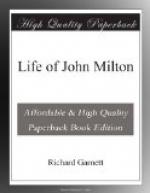The Civil War had no doubt interfered with Mr. Powell’s
ability to pay interest, but, on the other hand, must
have equally impaired Milton’s ability to exact
it; for the Powells were Cavaliers, and the Parliament’s
writ would run but lamely in loyal Oxfordshire.
Whether Milton went down on this eventful Whitsuntide
in the capacity of a creditor cannot now be known;
and a like uncertainty envelops the precise manner
of the metamorphosis of Mary Powell into Mary Milton.
The maiden of seventeen may have charmed him by her
contrast to the damsels of the metropolis, she may
have shielded him from some peril, such as might easily
beset him within five miles of the Royalist headquarters,
she may have won his heart while pleading for her
harassed father; he may have fancied hers a mind he
could mould to perfect symmetry and deck with every
accomplishment, as the Gods fashioned and decorated
Pandora. Milton also seems to imply that his,
or his bride’s, better judgment was partly overcome
by “the persuasion of friends, that acquaintance,
as it increases, will amend all.” It is
possible, too, that he had long been intimate with
his debtor’s family, and that Mary had previously
made an impression upon him. If not, his was
the most preposterously precipitate of poets’
marriages; for a month after leaving home he presented
a mistress to his astounded nephews and housekeeper.
The newly-wedded pair were accompanied or quickly followed
by a bevy of the bride’s friends and relatives,
who danced and sang and feasted for a week in the
quiet Puritan house, then departed—and after
a few weeks Milton finds himself moved to compose his
tract on the “Doctrine and Discipline of Divorce.”
How many weeks? The story seemed a straightforward
one until Professor Masson remarked what had before
escaped attention. According to Phillips, an
inmate of the house at the period—“By
that time she had for a month, or thereabouts, led
a philosophical life (after having been used to a
great house, and much company and joviality), her friends,
possibly incited by her own desire, made earnest suit
by letter to have her company the remaining part of
the summer, which was granted, on condition of her
return at the time appointed, Michaelmas or thereabout.
Michaelmas being come, and no news of his wife’s
return, he sent for her by letter, and receiving no
answer sent several other letters, which were also
unanswered, so that at last he dispatched down a foot-messenger;
but the messenger came back without an answer.
He thought it would be dishonourable ever to receive
her again after such a repulse, and accordingly wrote
two treatises,” &c. Here we are distinctly
assured that Mary Milton’s desertion of her husband,
about Michaelmas, was the occasion of his treatise
on divorce. It follows that Milton’s tract
must have been written after Michaelmas. But the
copy in the British Museum belonged to the bookseller
Thomason, who always inscribed the date of publication
on every tract in his collection, when it was known




